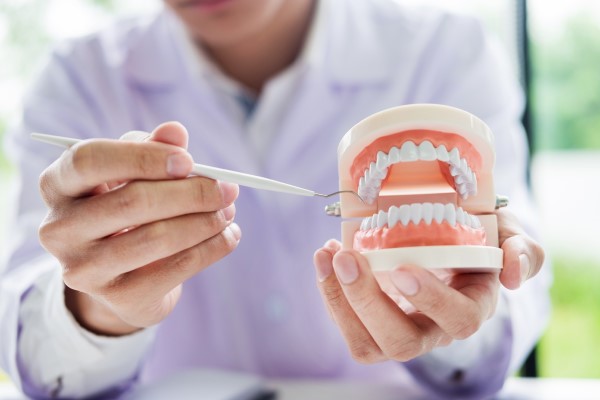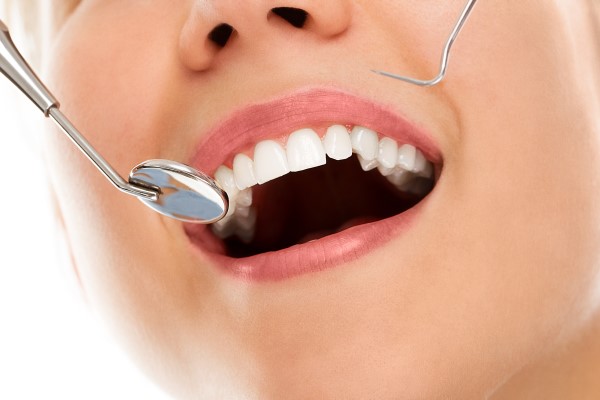Gum Disease: What Is Periodontitis?

Learning about the different stages of gum disease is important. With each stage, the disease progresses, making quick treatment important. When it comes to periodontitis, this stage of the disease is an advanced stage, which means there may already be damage to the gums and/or teeth.
The stages of gum disease
Even though making regular dental checkup appointments helps prevent patients from being diagnosed with gum disease in the first place, not all patients see their dentist on a regular basis. It is ideal for patients to be seen during the first stage of gum disease, as this is the easiest stage to treat. For patients who are past the first stage of gum disease, the sooner they make an appointment, the higher their chances are of undergoing successful gum disease treatment.
There are six different stages of gum disease: gingivitis, periodontitis, aggressive periodontitis, chronic periodontitis, systemic periodontitis and necrotizing periodontal disease. According to the American Academy of Periodontology, untreated gingivitis can advance to periodontitis and can eventually lead to tooth loss and other health problems.
About periodontitis
Periodontitis is a term used when gum disease begins to cause an infection of the gums. These gum infections will begin to damage the soft tissues within the mouth, as well as the bones in the mouth that directly support the teeth. Some of the more common signs of periodontitis include swollen gums, tender gums, bleeding gums, bright red gums, painful chewing, loose teeth and bad breath. As one can see by the information above, there are many stages of periodontitis disease, and depending on the stage one is in, it will determine the type of treatment they need to restore their good oral health.
When periodontitis is not treated in a timely manner, it is possible for the toxins created by the abundance of bacteria in the mouth to cause additional problems, e.g., gum irritation, gum separation, gum tissue loss, bone loss, chronic inflammation.
How general dentists address gum disease
When it comes to how a general dentist addresses gum disease in their patients, the first thing they will do is perform a dental examination in order to diagnose the stage of gum disease. Once they determine the stage, they will then create a dental treatment plan to address the gum disease. Examples of gum disease treatments include professional dental cleaning, scaling and root planing, flap surgery, bone grafts, soft tissue grafts and bone surgery.
Prevention is ideal when it comes to gum disease, which is why everyone needs to brush their teeth at least twice a day, floss their teeth at least once a day and make regular dental check-up appointments.
In need of gum disease treatment?
While many people know that they are living with gum disease, many others do not. This is why it is so important for everyone to make regular dental appointments, as regular dental check-ups can find any dental problems before they have a chance to get worse. When gum disease is not treated in a timely manner, it will only continue to get worse, eventually ending in tooth loss.
Request an appointment here: https://voguedental.com or call Vogue Dental at (309) 449-8888 for an appointment in our Normal office.
Check out what others are saying about our dental services on Yelp: Gum Disease in Normal, IL.
Recent Posts
At its core, gum disease is an infection that will spread as far as it can, but only if you let it. For this reason, dentists and periodontists recommend prevention and early detection.The infection that is gum disease becomes more challenging to manage the longer that it goes untreated. This explains why severe gum disease…
The Oral Cancer Foundation estimates that 53,000 people will be diagnosed with oral cancer over the coming year. The mortality rate of this cancer is higher than most other cancers, making early diagnosis through oral cancer screening and prevention critical in combating its effects. Patients frequently have numerous concerns regarding oral cancer and the screening…
Oral cancer includes cancers of the mouth as well as the back of the throat. Oral cancers develop on the tongue, at the base of the tongue and on the tissue lining the gums and mouth. They also develop under the tongue and in the area of the throat at the back of the mouth.…
When was your last dental checkup? Read on to learn more about the importance of regular dental care visits. A dental checkup visit with a dentist is a great way to detect the early signs of any oral health concerns and put together a restorative plan (if necessary) before the concerns worsen. Regular dental checkups…


